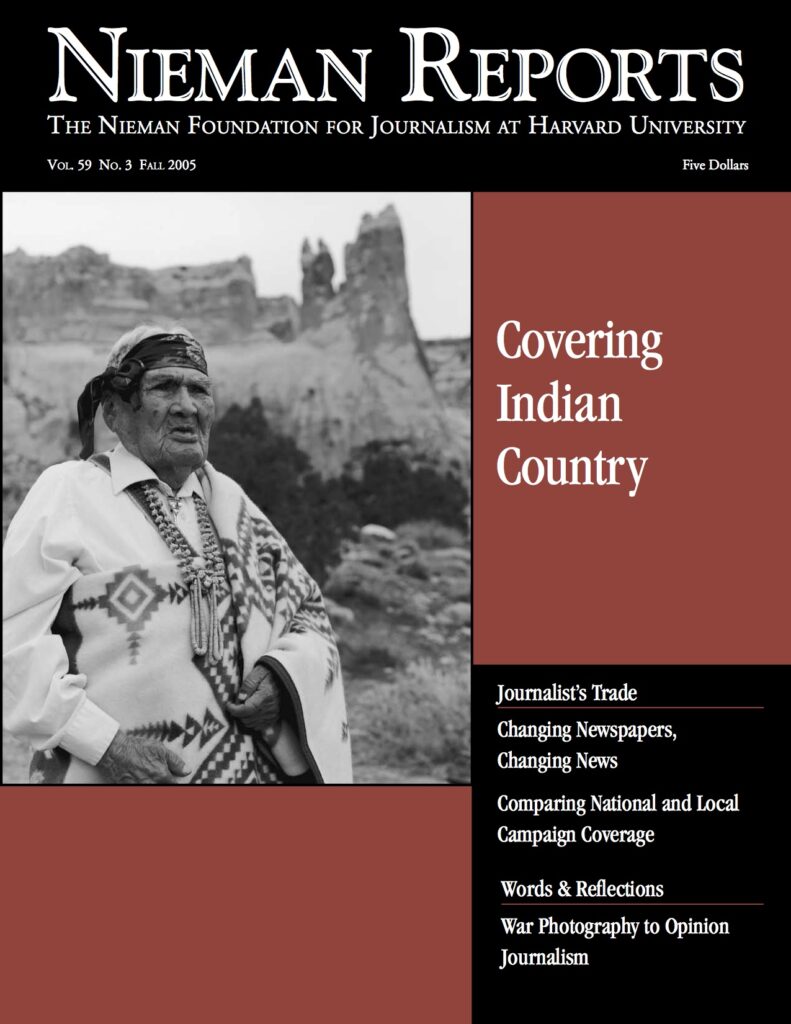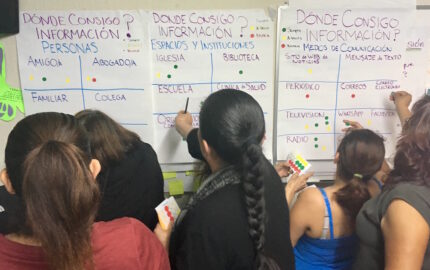Quick quiz: What college or university this year produced the largest number of Native American graduates looking for jobs in newspaper journalism? Let me knock about a million years off of your guessing time. The answer is East Central University (ECU) in Ada, Oklahoma.
Notice this is not a big journalism school. Neither is it one of the 33 small tribal colleges where most Native Americans (about 30,000) go to school. In the mini-world of Native American journalism, there is a number that is significantly smaller than the American Society of Newspaper Editors’ annual headcount of about 300 Native journalists working at daily newspapers. That’s the number of Native Americans studying journalism in college or at least preparing for a journalism career by doing internships each summer. The magic number that put East Central University over the top was two. Two of its graduates, Erny Zah, a Navajo and Mark Francis, a Muscogee (Creek), are on track to become staff reporters after completing internships this summer.
ECU technically is tied for this honor with Creighton University of Omaha, Nebraska, but ECU won the tiebreaker because it has a student in the wings. Jennifer McMahan-Curliss, a Timbisha Shoshone, will graduate next year with several internships under her belt, and one of Creighton’s graduates has decided already to quit her first full-time newspaper job and do volunteer work on a reservation in South Dakota. (The other Creighton graduate, photographer Tetona Dunlap, an Eastern Shoshone from Wyoming’s Wind River Reservation, became The Washington Post’s first and only Native American intern.)
I don’t think ECU actually tried to achieve this distinction or is even aware of it. It just happened. Then again, ECU or any school that Native Americans attend doesn’t have to teach journalism to its future Native reporters, editors and photographers as they earn degrees in something else. The reason: Native students can get their journalism lessons and experiences from other sources—and that is important news.
Young Native Americans and Journalism
Two programs—a summer institute and an online newspaper—train Native Americans in the basics of journalism, place them in paid internships at daily newspapers, and help them to find jobs. The Freedom Forum’s American Indian Journalism Institute [AIJI] teaches about 25 Native American college students how to write newspaper stories and take photographs in a three-week boot camp at the University of South Dakota each June. The reznet online newspaper then puts them to work during the school year as paid reporters and photographers. They use their reznet clips when they apply for internships, which many of them do through the Freedom Forum’s Chips Quinn Scholars Program.
RELATED ARTICLE
"Covering Indian Country: How an Outsider Gets In"
- Steve MagagniniReznet, which I created, is starting its fourth year as a joint project of the University of Montana School of Journalism and the Robert C. Maynard Institute for Journalism Education. The online newspaper operates as a sort of daily newspaper. Each school day, we put up on the site a new story. As editors (and teachers), we edit heavily and often. All of our exchanges with the students are done by e-mail and phone calls, and the Web site is created by a staff whose connection to one another is via computers. My student assistant, Craig Henry, attends the University of Oklahoma. He posts the edited stories and photos on the Web site, which is housed in Oakland, California. Three journalists pitch in as editors, again via e-mail—Steve Chin, with the Maynard Institute in Oakland, Victor Merina, of the University of Southern California’s Annenberg Institute for Justice and Journalism in Los Angeles, and Bill Elsen, a recently retired Washington Post editor and recruiter who lives in the Washington, D.C. suburbs. The three editors and I teach at the American Indian Journalism Institute during the summer.
With only one or two exceptions, all reznetters are graduates of AIJI. In fact, reznet is the school newspaper that Native students either don’t have at their schools or wouldn’t be caught dead working for. There are as many theories about Native Americans and journalism as there are Native Americans in journalism. Mine is pretty simple: Native students just don’t think about it, especially when they finally go to college. I say finally because the profile of the typical tribal college student is a 30-year-old single mother with a couple of kids.
When Native students do go to college, they’ve already made up their minds what they want to do, usually something for their tribes—and it isn’t journalism. One reason is that journalism is largely absent from their lives. Given the sparse number of Native journalists, Native young people don’t see themselves when they turn on the TV news or open a newspaper. Or the newspaper they read—the daily or weekly in the town or city nearest the reservation—is openly hostile to tribes or seems to go out of its way to make dumb mistakes about all things Indian (since most don’t have Natives in their newsrooms, either).
Most tribal newspapers tend to be little more than public relations mouthpieces for the tribal leaders, tightly controlled by the tribal governments that own them. Good tribal newspaper reporters and editors—those who attempt to report real news on their government bosses—spend a lot of time out of work, which is not exactly a ringing endorsement for a young person deciding on a career.
It gets even drearier: Tribal colleges don’t have journalism classes. If an occasional one is offered, it often is canceled because of lack of students. Or students don’t do real journalism in the classroom. One tribal college offered a journalism class taught by an out-of-work tribal newspaper editor who was a poet; the students’ first assignment was to find a sacred place, real or imagined, and write weepy words about it.
Creating Reznet
The reason I invented reznet was to use the Internet to reach out and teach journalism to—sometimes literally—the one Native kid in Wisconsin or Minnesota or Oklahoma or New Mexico or even New York who was interested in trying it. Reznet is also doing an important job of recruiting Native Americans into our journalism pipeline: Many of the AIJI and reznet students have said their initial interest in journalism came from reading reznet and seeing the work of other Native college students who have, in fact, become the missing role models. Erny Zah and Mark Francis are good examples. When he was accepted into AIJI, Mark talked his friend Erny into applying.
Last year we squeezed 35 students onto the reznet payroll. (We pay $50 for a story and give each student reporter a digital camera.) They came from 21 different colleges in 12 states, and they represent 25 tribes in 15 states. This spring, AIJI graduated its fifth class, adding another 23 Native students to the reznet talent pool.
The hallmark of AIJI is its strong and reliable internship program: Top graduates go immediately into six-week newspaper internships. After this June’s AIJI class, 17 graduates started paid internships at eight newspapers and an Associated Press (A.P.) bureau in seven states. The numbers we’ve compiled are impressive, though small. (Working with Native Americans is not for big-dreamer personality types.) This year, six graduates of AIJI got their first full-time jobs at daily newspapers (excluding the one who retreated to the reservation), and I expect at least another five more will find staff jobs next year, including Erny, Mark and Tetona.
Counting the new AIJI class, 58 Native college students have had internships since the program’s inception, and many have had multiple internships. Twenty-three AIJI grads from 15 colleges have received Chips Quinn internships. Three reznetters have had A.P. internships, and five have taken part in the A.P.’s Diverse Voices/Diverse Visions workshops. Three have been selected for the staff of the ASNE Reporter newspaper that reports on the annual conference of the American Society of Newspaper Editors. All nine Native students on the staff of The Unity News newspaper covering the 2004 Unity: Journalists of Color convention were reznetters.
The July 11, 2005 edition of the Argus Leader reflects the growing impact of these programs. AIJI grads who were interning at the Sioux Falls, South Dakota newspaper wrote the Page One lead story (a story by Virginia Perez about community opposition to moving a diner downtown) and the centerpiece articles in both the Life feature and Sioux Empire metro sections (another by Perez about multicultural marriages and a story about a bison petting zoo in nearby Minnesota by photographer Russel Daniels). And the AIJI graduate, Eric Bohlen, who was working as an intern at the Sioux Falls A.P. bureau, had a bylined story appear inside the metro section about an old gas station that pumped nostalgia, not gas.
I know there will be a day when the lead story in The Washington Post or The New York Times will be by a former reznetter and carry a byline with a name such as the ones that readers see every day on reznet: Bearchild, High Bear, Sings In The Timber, Walking Bull. That’s my small dream. With these essential building blocks in place, the reality is that now it’s an attainable one.
Denny McAuliffe, an Osage tribal member and former Washington Post foreign desk editor, is the reznet project director at the University of Montana School of Journalism. Reznet can be found at www.reznetnews.org.
Notice this is not a big journalism school. Neither is it one of the 33 small tribal colleges where most Native Americans (about 30,000) go to school. In the mini-world of Native American journalism, there is a number that is significantly smaller than the American Society of Newspaper Editors’ annual headcount of about 300 Native journalists working at daily newspapers. That’s the number of Native Americans studying journalism in college or at least preparing for a journalism career by doing internships each summer. The magic number that put East Central University over the top was two. Two of its graduates, Erny Zah, a Navajo and Mark Francis, a Muscogee (Creek), are on track to become staff reporters after completing internships this summer.
ECU technically is tied for this honor with Creighton University of Omaha, Nebraska, but ECU won the tiebreaker because it has a student in the wings. Jennifer McMahan-Curliss, a Timbisha Shoshone, will graduate next year with several internships under her belt, and one of Creighton’s graduates has decided already to quit her first full-time newspaper job and do volunteer work on a reservation in South Dakota. (The other Creighton graduate, photographer Tetona Dunlap, an Eastern Shoshone from Wyoming’s Wind River Reservation, became The Washington Post’s first and only Native American intern.)
I don’t think ECU actually tried to achieve this distinction or is even aware of it. It just happened. Then again, ECU or any school that Native Americans attend doesn’t have to teach journalism to its future Native reporters, editors and photographers as they earn degrees in something else. The reason: Native students can get their journalism lessons and experiences from other sources—and that is important news.
Young Native Americans and Journalism
Two programs—a summer institute and an online newspaper—train Native Americans in the basics of journalism, place them in paid internships at daily newspapers, and help them to find jobs. The Freedom Forum’s American Indian Journalism Institute [AIJI] teaches about 25 Native American college students how to write newspaper stories and take photographs in a three-week boot camp at the University of South Dakota each June. The reznet online newspaper then puts them to work during the school year as paid reporters and photographers. They use their reznet clips when they apply for internships, which many of them do through the Freedom Forum’s Chips Quinn Scholars Program.
RELATED ARTICLE
"Covering Indian Country: How an Outsider Gets In"
- Steve MagagniniReznet, which I created, is starting its fourth year as a joint project of the University of Montana School of Journalism and the Robert C. Maynard Institute for Journalism Education. The online newspaper operates as a sort of daily newspaper. Each school day, we put up on the site a new story. As editors (and teachers), we edit heavily and often. All of our exchanges with the students are done by e-mail and phone calls, and the Web site is created by a staff whose connection to one another is via computers. My student assistant, Craig Henry, attends the University of Oklahoma. He posts the edited stories and photos on the Web site, which is housed in Oakland, California. Three journalists pitch in as editors, again via e-mail—Steve Chin, with the Maynard Institute in Oakland, Victor Merina, of the University of Southern California’s Annenberg Institute for Justice and Journalism in Los Angeles, and Bill Elsen, a recently retired Washington Post editor and recruiter who lives in the Washington, D.C. suburbs. The three editors and I teach at the American Indian Journalism Institute during the summer.
With only one or two exceptions, all reznetters are graduates of AIJI. In fact, reznet is the school newspaper that Native students either don’t have at their schools or wouldn’t be caught dead working for. There are as many theories about Native Americans and journalism as there are Native Americans in journalism. Mine is pretty simple: Native students just don’t think about it, especially when they finally go to college. I say finally because the profile of the typical tribal college student is a 30-year-old single mother with a couple of kids.
When Native students do go to college, they’ve already made up their minds what they want to do, usually something for their tribes—and it isn’t journalism. One reason is that journalism is largely absent from their lives. Given the sparse number of Native journalists, Native young people don’t see themselves when they turn on the TV news or open a newspaper. Or the newspaper they read—the daily or weekly in the town or city nearest the reservation—is openly hostile to tribes or seems to go out of its way to make dumb mistakes about all things Indian (since most don’t have Natives in their newsrooms, either).
Most tribal newspapers tend to be little more than public relations mouthpieces for the tribal leaders, tightly controlled by the tribal governments that own them. Good tribal newspaper reporters and editors—those who attempt to report real news on their government bosses—spend a lot of time out of work, which is not exactly a ringing endorsement for a young person deciding on a career.
It gets even drearier: Tribal colleges don’t have journalism classes. If an occasional one is offered, it often is canceled because of lack of students. Or students don’t do real journalism in the classroom. One tribal college offered a journalism class taught by an out-of-work tribal newspaper editor who was a poet; the students’ first assignment was to find a sacred place, real or imagined, and write weepy words about it.
Creating Reznet
The reason I invented reznet was to use the Internet to reach out and teach journalism to—sometimes literally—the one Native kid in Wisconsin or Minnesota or Oklahoma or New Mexico or even New York who was interested in trying it. Reznet is also doing an important job of recruiting Native Americans into our journalism pipeline: Many of the AIJI and reznet students have said their initial interest in journalism came from reading reznet and seeing the work of other Native college students who have, in fact, become the missing role models. Erny Zah and Mark Francis are good examples. When he was accepted into AIJI, Mark talked his friend Erny into applying.
Last year we squeezed 35 students onto the reznet payroll. (We pay $50 for a story and give each student reporter a digital camera.) They came from 21 different colleges in 12 states, and they represent 25 tribes in 15 states. This spring, AIJI graduated its fifth class, adding another 23 Native students to the reznet talent pool.
The hallmark of AIJI is its strong and reliable internship program: Top graduates go immediately into six-week newspaper internships. After this June’s AIJI class, 17 graduates started paid internships at eight newspapers and an Associated Press (A.P.) bureau in seven states. The numbers we’ve compiled are impressive, though small. (Working with Native Americans is not for big-dreamer personality types.) This year, six graduates of AIJI got their first full-time jobs at daily newspapers (excluding the one who retreated to the reservation), and I expect at least another five more will find staff jobs next year, including Erny, Mark and Tetona.
Counting the new AIJI class, 58 Native college students have had internships since the program’s inception, and many have had multiple internships. Twenty-three AIJI grads from 15 colleges have received Chips Quinn internships. Three reznetters have had A.P. internships, and five have taken part in the A.P.’s Diverse Voices/Diverse Visions workshops. Three have been selected for the staff of the ASNE Reporter newspaper that reports on the annual conference of the American Society of Newspaper Editors. All nine Native students on the staff of The Unity News newspaper covering the 2004 Unity: Journalists of Color convention were reznetters.
The July 11, 2005 edition of the Argus Leader reflects the growing impact of these programs. AIJI grads who were interning at the Sioux Falls, South Dakota newspaper wrote the Page One lead story (a story by Virginia Perez about community opposition to moving a diner downtown) and the centerpiece articles in both the Life feature and Sioux Empire metro sections (another by Perez about multicultural marriages and a story about a bison petting zoo in nearby Minnesota by photographer Russel Daniels). And the AIJI graduate, Eric Bohlen, who was working as an intern at the Sioux Falls A.P. bureau, had a bylined story appear inside the metro section about an old gas station that pumped nostalgia, not gas.
I know there will be a day when the lead story in The Washington Post or The New York Times will be by a former reznetter and carry a byline with a name such as the ones that readers see every day on reznet: Bearchild, High Bear, Sings In The Timber, Walking Bull. That’s my small dream. With these essential building blocks in place, the reality is that now it’s an attainable one.
Denny McAuliffe, an Osage tribal member and former Washington Post foreign desk editor, is the reznet project director at the University of Montana School of Journalism. Reznet can be found at www.reznetnews.org.



